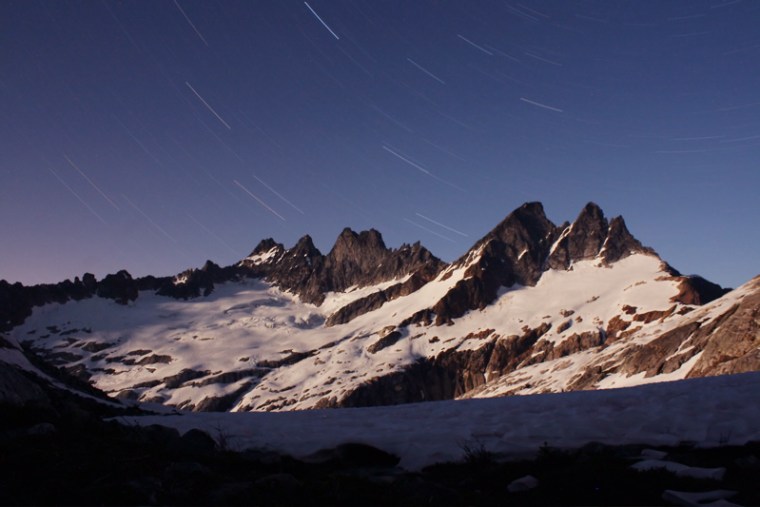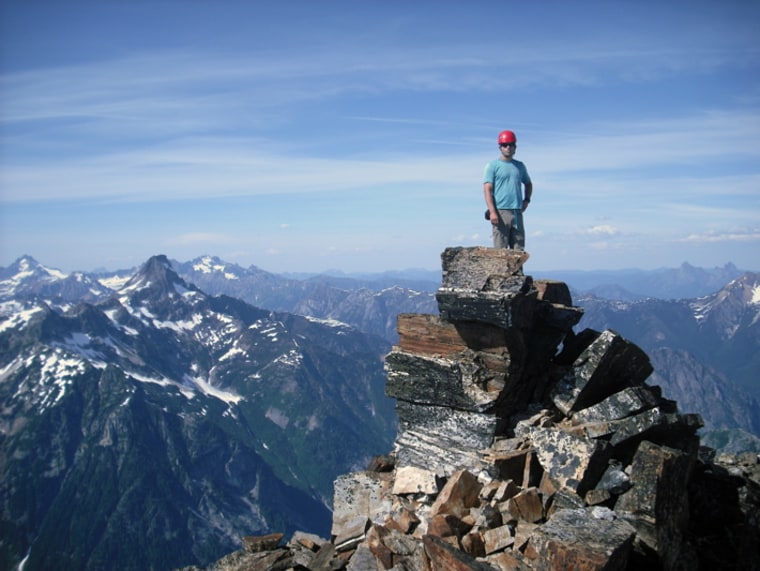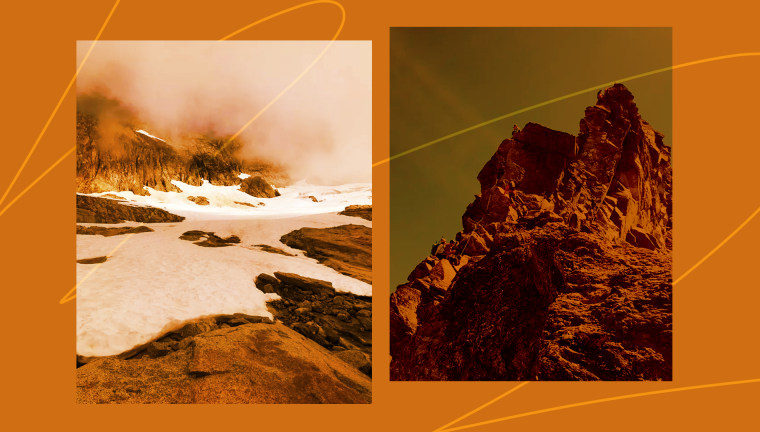A spectacular but little-visited national park northeast of Seattle has a higher death rate than any other site in the park system, according to an NBC News analysis of 15 years of federal data. And some climbers and guides are worried that without changes at North Cascades National Park, officials could be amplifying its dangers.
The park had 3.7 deaths for every 100,000 visitors from 2007 to 2021, more than three times the rate of the next-deadliest site, Wrangell-St. Elias National Park Reserve in southern Alaska, according to the data from the National Park Service.
Fourteen people died in North Cascades in those 15 years, when an average of just over 25,000 people visited annually — or considerably fewer than at well-known parks like Lake Mead, Yosemite or Grand Canyon. Death totals in those parks were far higher, as were the numbers of visitors.
The causes of death weren’t listed in the data, which was obtained through a public records request from North Cascades. The agency hasn’t processed a separate records request for causes of death.
The North Cascades National Park “complex” includes two national recreation areas popular with boaters, but the park’s namesake site is a well-known mountaineering destination, with routes included in the beloved guide “The 50 Classic Climbs of North America.”
Kelly Bush, a former ranger who worked for North Cascades for more than three decades and oversaw its search and rescue operations, said many of the deaths she knew about were among alpine climbers and hikers — people plunging from mountains or fatally wounded by falling rock and ice.
Another park popular with alpine climbers, Alaska’s Denali National Park and Preserve, draws an average of more than half a million visitors a year — about 20 times as many as North Cascades. If Denali had the same death rate as North Cascades, it would record an average of 16 deaths a year, according to the analysis.
Some climbers and guides said park officials could do more to make North Cascades less risky, like allowing the careful, limited use of “bolted anchors,” devices fixed into rock that effectively tether climbers to mountains. The anchors are the safest, sturdiest and perhaps most divisive equipment climbers can use to protect themselves from falling — some oppose them because they permanently alter the landscape.
It isn’t clear whether the park will allow the anchors. Much of North Cascades is wilderness, and park officials are known for their fierce protection of those lands and an embrace of traditional mountaineering, with its leave-no-trace mantra.
But a longtime guide made an ominous prediction: If officials don’t allow climbers to make some of its most popular routes safer, the park could suffer more accidents, injuries and deaths.
To account for the possibility of errors in park service data and potentially higher visitor numbers, NBC News more than doubled the average number of annual visitors. The adjusted death rate — 1.85 for every 100,000 visitors — was still higher than the rate of 1.09 for Wrangell-St. Elias National Park & Preserve, according to the analysis.
Cynthia Hernandez, a park service spokeswoman, said in an email that several years of the data obtained by NBC News are preliminary and could change after a review.
It isn’t clear how many people have been injured in climbing and hiking accidents at North Cascades. Hernandez said there were “numerous, and often not reported, non-fatal injuries and near misses” within the national park system.
She said slips, trips, falls, drownings and car accidents were the most common ways visitors to parks get hurt.
“Each park has inherent and unique risks, and while some park activities are riskier than others, it does not necessarily make the park more ‘dangerous,’” Hernandez said.

'A very hazardous park'
Climbers, guides and Bush, the former North Cascades ranger, described the nearly 800-square-mile park as a magnificent and rugged wilderness, a place with dramatic ridges and valleys, hundreds of glaciers, almost no infrastructure and, at least for the lower 48, an uncommon remoteness. Volatile weather and an unstable landscape magnified by climate change can also make it dangerous.
Part of North Cascades' website is devoted to warning visitors of the park's many risks and offering tips about how to safely navigate them.
“It’s a very hazardous park,” said Bush, the former ranger who also oversaw the park’s mountaineering program before she retired nearly a decade ago. “It would be easy to die in that park.”
Bush said that in the 36 years she worked at North Cascades, most of the deaths she encountered were among “very” experienced climbers.
“That’s who goes to North Cascades,” she said.
Some climbers pointed to the park’s ban on bolted anchors as another potential source of danger.
The rule, which echoes a long-standing debate in the climbing world over how much people should be allowed to alter the wilderness, means visitors must rely on other, less secure anchors, like nylon webbing, said Erik Murdock, the vice president of policy and government affairs for the Access Fund, a nonprofit organization that advocates for climbers and supports the use of bolted anchors.
Asked about the ban, Hernandez pointed to the park’s lengthy “compendium” of policies, which says fixed anchors are prohibited within North Cascades' wilderness area.
According to the park’s website, the ban is designed to “preserve a wilderness experience that reflects a raw style of mountaineering.”
The point of the policy, Bush said, was to avoid turning the wilderness into a “climbing gym with bolts all over the mountain.” She declined to say whether she supported the use of bolted anchors in North Cascades.
Murdock said that visitors should aim to leave as little as possible behind but that in an area like North Cascades, a properly placed stainless steel bolt is far more lasting and reliable than webbing.
The longtime guide with the ominous warning said there appear to be few rules for temporary anchors, describing it as a "free-for-all."
People "end up in dangerous places because they see anchors in the middle of nowhere,” said the guide, who has been visiting North Cascades since the late ’90s and asked not to be identified over fear of retribution from the park, which issues permits.
Another guide, Josh Cole of North Cascades Mountain Guides, said he routinely sees "near misses" at the park because of the lack of high-quality fixed anchors.
Hernandez, the park spokeswoman, didn’t respond to a request for comment about potential hazards associated with temporary anchors. She said protective equipment that doesn't require drilling and altering of natural features — such as webbing — may be left in place.
A death on Forbidden Peak
Murdock pointed to a pair of incidents about a decade ago that underscore the issue.
In August 2012, an off-duty guide replaced what Murdock described as an old, unsafe “sling” anchor with two bolts on the West Ridge of Forbidden Peak, one of the park’s most popular routes. At the time, there was no documented policy about the matter, and the guide was trying to protect climbers from rockfall by establishing a safer route, Murdock said.
Bush said she alerted the park’s top official about the bolts. Within days, North Cascades rangers had removed — or “chopped” — the anchors. They also removed a second, older set of bolts on the route, she said.
The guide who installed the bolts didn't respond to requests for comment. Bush said the guide never asked the park for permission, nor did he mention wanting to establish a safer route to two rangers he encountered shortly before he installed them.

After their removal — and without public discussion — North Cascades’ superintendent added the regulation to the park compendium that prohibited bolted anchors, Bush said. (Hernandez said public notice is required for compendium actions; a public comment period isn't.)
A month later, the guide who asked not to be identified surveyed Forbidden Peak’s West Ridge descent and complained to the Access Fund about how perilous the route had become after the bolts were removed — and how exposed to rockfall it was.
“It still amazes me that they would go out of their way to make this dangerous descent more dangerous,” the guide wrote in an email that Murdock provided to NBC News. “In my professional opinion this is just an accident waiting to happen.”
A year after the removal, on Sept. 14, 2013, a climber descending Forbidden Peak’s West Ridge was hit by a falling rock and plunged 300 feet to his death, according to an account Bush wrote three days later.
His climbing partner told the climbing magazine Rock and Ice that before he was struck by the football-size rock, he had been forced to remove his rope and traverse a narrow ledge to try to reach an old anchor.
“Because the bolts weren’t there, it pushed him into a zone where there was rockfall,” Murdock said. “Does that mean it caused his death? I don’t think you can say that.”
For the guide who offered the dire warning, the death illustrated the potential peril at North Cascades — and it “likely won’t be the last if that descent doesn’t change,” he said.
Hernandez said, "Climbing carries inherent risks, including the risk of rockfall, which could happen at any point during a climb."
The bolts were removed in a manner consistent with park policies and laws, she said, and Forbidden Peak's West Ridge has been climbed for years without fixed anchors.
"Every time a climber puts on their harness, it is their personal responsibility to assess possible dangers and identify an acceptable level of risk they are willing to take," she said, adding that officials encourage visitors to check park policies and ensure they're familiar with "clean" climbing techniques.
Before the fatal fall, the Access Fund and other groups had been pushing the park to develop an authorization process for fixed anchors, including bolts, Murdock said. He pointed to National Park Service guidance from 2013 that says sites with wilderness areas should do just that, while also ensuring that fixed anchors remain rare.
Cole, of North Cascades Mountain Guides, said there are pros and cons to allowing bolts in the park. But, he said, “ultimately the decision is being made by a small group of people without input from the climbing community.”
Murdock said park officials promised to address the matter in a wilderness management plan revision that would allow public input.
“They said in 2014 or 2015 it would take a couple years,” Murdock said. “They haven’t even started it.”
Hernandez wrote that the park intends to hold a public planning process for climbing and wilderness stewardship in the "near future."
"Until the park can meet this planning requirement or approves a permit, fixed anchors (bolts) remain prohibited," she said.
A nearly fatal fall and a daring rescue
Jason Martin, the executive director of the American Alpine Institute in Bellingham, Washington, a climbing school and guide service, pointed to other factors that are likely to make the park prone to danger. The warming climate, for instance, is taking a toll on the region’s glaciers, sending them into retreat and wreaking havoc on the landscape they’ve long helped bind together.
The shift has made permanent snowfields looser and prompted more rockfall and icefall, he said. One of the park’s most popular routes, Price Glacier, is barely climbable now, he said.
“It’s falling apart,” Martin said. “There are these giant car-size blocks of ice falling down.”

For Steven Trent, a commercial pilot who has been climbing at the park since the 1990s, a near-death experience came down to a loose rock on a rarely used trail.
On July 5, 2009, he and a partner were simul-climbing a peak called Mount Terror when he knocked the rock loose and it tumbled down the mountain. Trent said he plunged dozens of feet, bouncing off the mountain and stopping only when he reached the end of the rope connecting him to his climbing partner, Steph Abegg.
According to an account Abegg published on her website, what followed was a desperate effort to get help — one that involved on-the-fly first aid administered on the side of a mountain and a risky rescue in which Trent was scooped up by a ranger dangling from a helicopter in blowing winds.
Trent had torn his Achilles tendon, broken his left femur and suffered a nasty gash on his head. Seeing the approaching pilot, he said, was like seeing Superman.
Trent made a full recovery and went on to climb the same route again without incident a few years later. But had a member of their climbing party not brought a cellphone — and had they not found a signal deep in the wilderness, a stroke of luck that allowed them to call for help — things could have turned out differently, Abegg said.
We “would have hiked out and they would have gotten him,” Abegg said. “But he might not have made it.”

